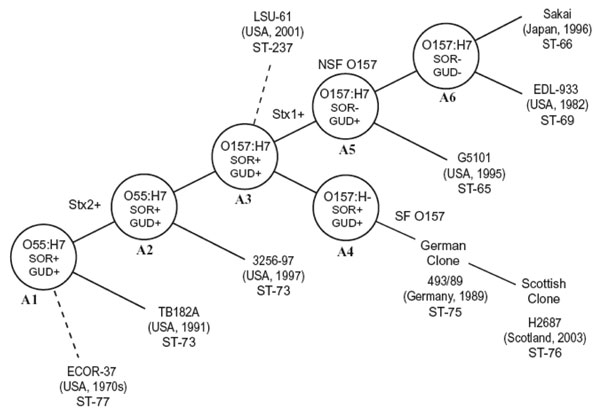Volume 13, Number 11—November 2007
Research
Genetic Diversity among Clonal Lineages within Escherichia coli O157:H7 Stepwise Evolutionary Model
Figure 3

Figure 3. Evolution model for Escherichia coli O157:H7. Figure modified and updated from (1) to include the sequence type (ST) data showing subclones within clonal complexes. Some strains, whose position on the model remains to be determined, are shown with dashed lines.
References
- Feng P, Lampel K, Karch H, Whittam T. Genotypic and phenotypic changes in the emergence of E. coli O157:H7. J Infect Dis. 1998;177:1750–3. DOIPubMedGoogle Scholar
- Whittam TS, Wolfe M, Wachsmuth I, Orskov F, Orskov I, Wilson R. Clonal relationships among Escherichia coli strains that cause hemorrhagic colitis and infantile diarrhea. Infect Immun. 1993;61:1619–29.PubMedGoogle Scholar
- Monday SR, Whittam T, Feng P. Genetic and evolutionary analysis of mutations in the gusA gene that caused the absence of β-glucuronidase activity in Escherichia coli O157:H7. J Infect Dis. 2001;184:918–21. DOIPubMedGoogle Scholar
- Monday SR, Minnich S, Feng P. A 12 base-pair deletion in the flagellar master control gene flhC causes non-motility of the pathogenic German sorbitol-fermenting Escherichia coli O157:H- strains. J Bacteriol. 2004;186:2319–27. DOIPubMedGoogle Scholar
- Hayes PS, Blom K, Feng P, Lewis J, Strockbine N, Swaminathan B. Isolation and characterization of a β-D-glucuronidase-producing strain of Escherichia coli O157:H7 in the United States. J Clin Microbiol. 1995;33:3347–8.PubMedGoogle Scholar
- Karch H, Bielaszewska M. Sorbitol-fermenting Shiga toxin-producing Escherichia coli O157:H- strains: epidemiology, phenotypic and molecular characteristics and microbiological diagnosis. J Clin Microbiol. 2001;39:2043–9. DOIPubMedGoogle Scholar
- Nagano H, Okui T, Fujiwara O, Uchiyama Y, Tamate N, Kumada H, Clonal structure of Shiga toxin (Stx)-producing and β-D-glucuronidase-positive Escherichia coli O157:H7 strains isolated from outbreaks and sporadic cases in Hokkaido, Japan. J Med Microbiol. 2002;51:405–16.PubMedGoogle Scholar
- Bielaszewska M, Schmidt H, Liesgang A, Prager R, Rabach W, Tschape H, Cattle can be a reservoir of sorbitol-fermenting shiga toxin–producing Escherichia coli O157:H- strains and a source of human disease. J Clin Microbiol. 2000;38:3470–3.PubMedGoogle Scholar
- Ammon A, Petersen LR, Karch H. A large outbreak of hemolytic uremic syndrome caused by an unusual sorbitol-fermenting strain of Escherichia coli O157:H-. J Infect Dis. 1999;179:1274–7. DOIPubMedGoogle Scholar
- Gerber A, Karch H, Allerberger F, Verweyen H, Zimmerhackl L. Clinical course and the role of shiga toxin-producing Escherichia coli infection in the hemolytic-uremic syndrome in pediatric patients, 1997–2000, in Germany and Austria: a prospective study. J Infect Dis. 2002;186:493–500. DOIPubMedGoogle Scholar
- Bielaszewska M, Schmidt H, Karmali M, Khakhria R, Janda J, Bláhová K, Isolation and characterization of sorbitol-fermenting Shiga toxin (verocytotoxin)–producing Escherichia coli O157:H- strains in the Czech Republic. J Clin Microbiol. 1998;36:2135–7.PubMedGoogle Scholar
- Eklund M, Bielaszewska M, Nakari U, Karch H, Siitonen A. Molecular and phenotypic profiling of sorbitol-fermenting Escherichia coli O157:H- human isolates from Finland. Clin Microbiol Infect. 2006;12:634–41. DOIPubMedGoogle Scholar
- Saari M, Cherasty T, Leino K, Siitonen A. Phage types and genotypes of shiga toxin–producing Escherichia coli O157 in Finland. J Clin Microbiol. 2001;39:1140–3. DOIPubMedGoogle Scholar
- Taylor P, Allison L, Willshaw G, Cheasty T, Hanson M. Sorbitol-fermenting Escherichia coli O157 in Scotland. 5th International Symposium on Shiga Toxin (Verotoxin)–producing E. coli Infections. Edinburgh, Scotland, 2003 Jun. Abstract no. P280.
- Karch H, Bohm H, Schmidt H, Gunzer F, Aleksic S, Heesemann J. Clonal structure and pathogenicity of Shiga-like toxin-producing, sorbitol-fermenting Escherichia coli O157:H-. J Clin Microbiol. 1993;31:1200–5.PubMedGoogle Scholar
- Dunn JR, Keen JE, Moreland D, Thompson R. Prevalence of Escherichia coli O157:H7 in white-tailed deer from Louisiana. J Wildl Dis. 2004;40:361–8.PubMedGoogle Scholar
- Feng P, Monday S. Multiplex PCR for detection of trait and virulence factors in enterohemorrhagic Escherichia coli serotypes. Mol Cell Probes. 2000;14:333–7. DOIPubMedGoogle Scholar
- Bettelheim KA. Identification of enterohemorrhagic Escherichia coli by means of their production of enterohemolysin. J Appl Bacteriol. 1995;79:178–80.PubMedGoogle Scholar
- Centers for Disease Control and Prevention. Standardized molecular subtyping of foodborne bacterial pathogens by pulsed-field gel electrophoresis: CDC training manual. Atlanta: The Centers; 2003.
- Qi W, Lacher D, Bumbaugh A, Hyma K, Ouellette L, Large T, EcMLST: an online database for multi locus sequence typing of pathogenic Escherichia coli. Proceedings of the Institute of Electrical and Electronics Engineers (IEEE) Computational Systems Bioinformatics Conference, 2004. Washington: IEEE Computer Society; 2004.
- Zhang WL, Kohler B, Oswald E, Beutin L, Karch H, Morabito S, Genetic diversity of intimin genes of attaching effacing Escherichia coli strains. J Clin Microbiol. 2002;40:4486–92. DOIPubMedGoogle Scholar
- Nagano H, Hirochi T, Fujita K, Wakamori Y, Takeshi K, Yano S. Phenotypic and genotypic characterization of β-D-glucuronidase–positive Shiga toxin–producing Escherichia coli O157:H7 isolated from deer. J Med Microbiol. 2004;53:1037–43. DOIPubMedGoogle Scholar
- McGraw EA, Li J, Selander R, Whittam T. Molecular evolution and mosaic structure of α, β, and γ intimins of pathogenic Escherichia coli. Mol Biol Evol. 1999;16:12–22.PubMedGoogle Scholar
- Karch H, Meyer T, Russmann H, Heesemann J. Frequent loss of Shiga-like toxin genes in clinical isolates of Escherichia coli upon subcultivation. Infect Immun. 1992;60:3464–7.PubMedGoogle Scholar
- Besser TE, Shaikh N, Holt N, Tarr P, Konkel M, Malik-Kale P, Greater diversity of shiga toxin-encoding bacteriophage insertion sites among Escherichia coli O157:H7 isolates from cattle than in those from humans. Appl Environ Microbiol. 2007;73:671–9. DOIPubMedGoogle Scholar
Page created: July 05, 2010
Page updated: July 05, 2010
Page reviewed: July 05, 2010
The conclusions, findings, and opinions expressed by authors contributing to this journal do not necessarily reflect the official position of the U.S. Department of Health and Human Services, the Public Health Service, the Centers for Disease Control and Prevention, or the authors' affiliated institutions. Use of trade names is for identification only and does not imply endorsement by any of the groups named above.